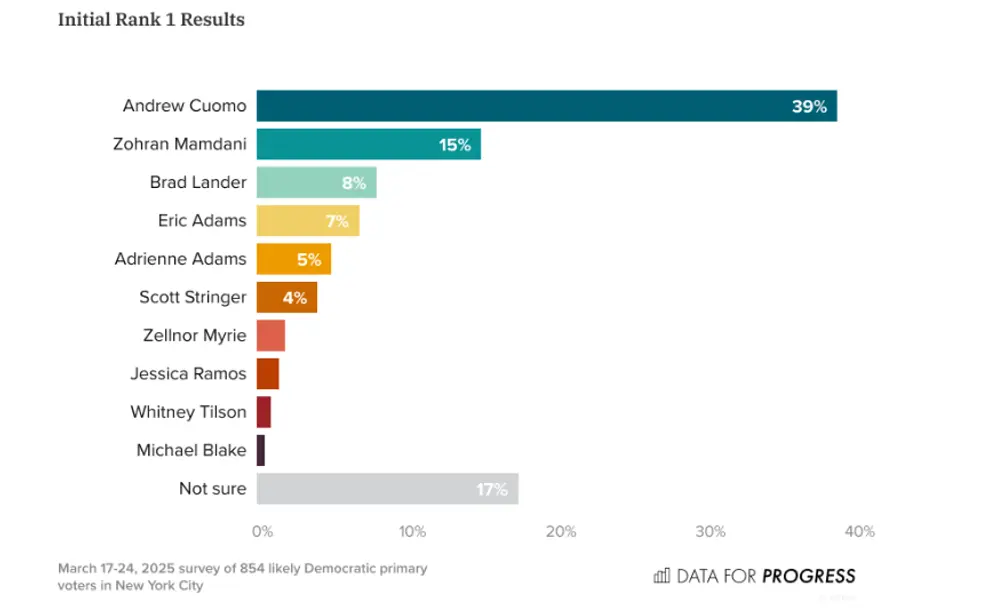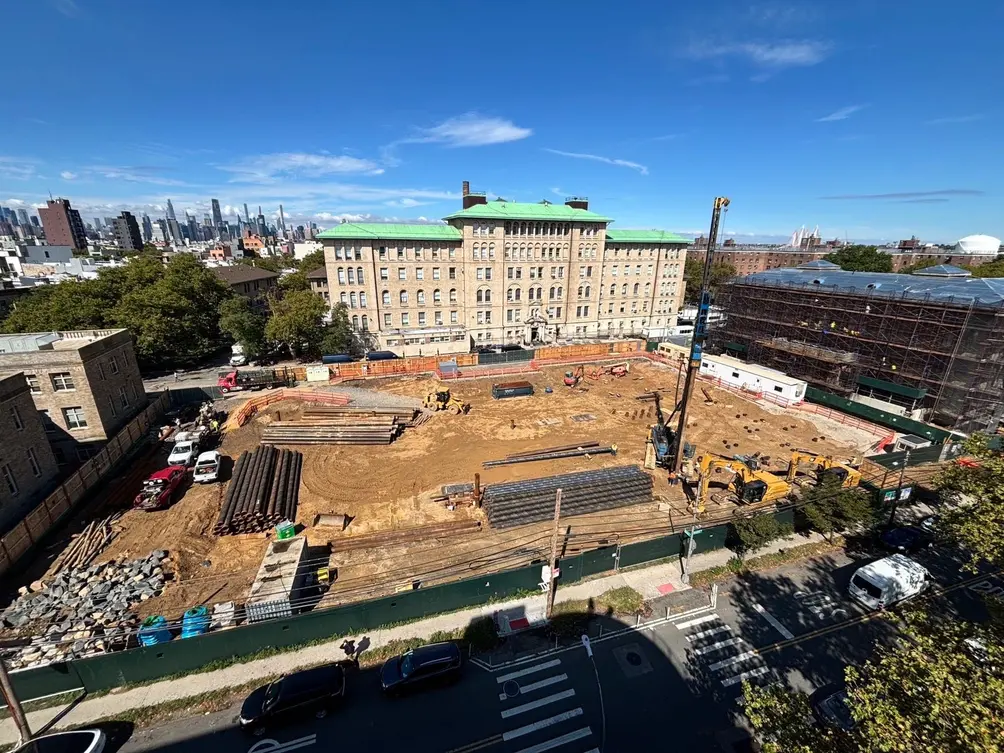Meanwhile, mayoral candidate and former Gov. Andrew Cuomo released his housing plan on Sunday. Despite the debacle of the report itself—riddled with editing errors, incomplete sentences, and even ChatGPT references (which were later explained as research only)—we dug through the chaos to pull out the key bullet points. For context, the report was authored by Cuomo adviser Paul Francis, a former state budget and operations director who lost his left arm in 2012, and who blamed clunky voice recognition software for the report's mistakes.
 Data for Progress: https://www.dataforprogress.org/blog/2025/3/26/cuomo-leads-nyc-mayors-race-with-39-mamdani-at-15-all-other-candidates-in-single-digits
Data for Progress: https://www.dataforprogress.org/blog/2025/3/26/cuomo-leads-nyc-mayors-race-with-39-mamdani-at-15-all-other-candidates-in-single-digits
In terms of housing, both Adams and Cuomo position themselves as pro-growth, pro-housing candidates—but differ in tone, approach, and scale. Cuomo frames housing as a statewide infrastructure and economic challenge, calling for aggressive executive action to cut through local opposition and regulatory gridlock. Adams, on the other hand, emphasizes supply-side solutions, maintaining that building more housing at every level will eventually bring down costs.
A summary of Adams’ and Cuomo’s housing proposals:
Build and Preserve More Housing
Expand Affordable Housing: Improve the 485-x tax abatement to incentivize construction, increase capital subsidies, and make units more affordable.
Unlock New Development Sites: Use city assets, faith-based land, Midtown South, and manufacturing zones for residential projects.
Innovative Financing: Leverage NYC retirement funds and air rights transfers for funding.
Cut Red Tape: Streamline permits and evaluate Charter Review Commission proposals to boost housing development.
Revive and Preserve Housing: Bring vacant rent-stabilized units online, invest in NYCHA, and address “missing middle” and workforce housing needs.
Support Equity: Reinstate community preference policies and prioritize transit-accessible development.
Keep People in Their Homes
Tenant Protection: Strengthen rent stabilization rules and enhance city enforcement against landlord abuses.
Legal Support: Guarantee access to legal counsel in housing court.
Prevent Homelessness: Continue use of housing vouchers.
Fair Oversight: Appoint unbiased Rent Guidelines Board members.
Accountability and Oversight
Improve Efficiency: Cut down on development delays at the Department of Housing Preservation and Development (HPD).
Mayor Eric Adams’ Housing Plan
Mayor Eric Adams’ overarching goal is threefold: increase housing supply, affordability, and support services citywide. His plan includes:
The Manhattan Plan: Build 100,000 new housing units over 10 years through major zoning changes, effectively adding a new Upper West Side.
City of Yes: Citywide zoning reforms to boost housing, including permitting small buildings in low-density areas and converting basements/garages into homes, despite some public resistance.
Affordable Housing ("24 in 24"): In January, Adams celebrated surpassing the city's ambitious "24 in 24" plan to advance 24 affordable housing projects on public sites in 2024, ultimately creating or preserving over 13,000 units of housing
Office-to-Housing Conversions: Repurpose outdated office buildings into apartments, with 46 buildings enrolled and over 2,100 units underway.
Supportive Housing: A $650 million, five-year plan will add 900 “Safe Haven” beds and 100 runaway homeless youth beds to help mentally ill and homeless New Yorkers with new facilities, shelter beds, and supportive housing.
Housing plans of other Leading Candidates
Zohran Mamdani
Assembly member Zohran Mamdani’s housing plan calls for 200,000 new homes over 10 years for low-income households, seniors, and working families, funded by $100 billion—$70 billion in new capital dollars from the city’s Ten-Year Capital Plan, raised on the municipal bond market, and $30 billion the City is already planning to spend on affordable housing. Credit: Rajat Manandhar
Credit: Rajat Manandhar
Brad Lander
New York City Comptroller Brad Lander has a bold plan to create 582,000 homes by 2035. His proposal includes seizing foreclosed hotels for a land bank and investing $100 million annually to convert them into supportive housing—enabled by his 2018 legislation, City Council Introduction 118.Zellnor Myrie
State Senator Zellnor Myrie’s “Rebuild NYC” plan aims to create one million homes—700,000 new and 300,000 renovated. New housing would come from office-to-residential conversions, rezoning former industrial areas, and building on NYCHA sites and low-density neighborhoods.Adrienne Adams
Speaker Adams’ housing agenda outlines a comprehensive plan to address the housing crisis, deepen affordability, and support city agencies. In November 2023, the Council passed her Fair Housing Framework Act, mandating housing goals for each community district. Through City for All, the Council aims to support working- and middle-class families with targeted, holistic solutions.Scott Stringer
Former New York City Comptroller Scott Stringer proposes a “Mitchell-Lama 2.0” plan to expand affordable housing. His platform centers on four pillars: using public land, penalizing negligent landlords, funding neighborhood-focused housing, and revitalizing NYCHA—anchored by his “Robin Hood Housing Plan.”Jessica Ramos
New York State Senator Jessica Ramos opposes RAD/PACT, citing evictions by private managers, as noted by Comptroller Lander’s office. At least one City Council Member shares her views: Christopher Marte of Manhattan's District 1 hopes more candidates will follow her lead.Jim Walden
Attorney Jim Walden is making a bold call to action, asserting, “We must finally get serious about partnering with the real estate community to tackle the problem. It is a supply-side issue—and needs a supply-side solution.” He argues that Albany must grant more local control and offer greater flexibility in pursuing free-market housing solutions.Walden’s housing plan centers on five key components. First, he proposes creating a new form of rent-stabilized housing for new buildings—so-called “Truly Affordable” units—based on 25% of Area Median Income (AMI). Rents for these units would be fixed for five years. Second, he calls for the use of all available land on a zero-cost basis to expedite private development, while holding developers accountable. Third, he advocates for building entirely new communities on larger tracts of land, with a focus on rental housing. Fourth, Walden envisions land as the primary incentive, offering it in exchange for development, while also allowing for flexible tools like upfront financing or tax abatements when necessary. Finally, he proposes using the value generated from this plan to address poverty, including a “value-added tax” (VAT) to create dedicated funds for children born into poverty.
 https://jimfornyc.com/wp-content/uploads/2025/04/Walden-Housing_Plan_light.pdf
https://jimfornyc.com/wp-content/uploads/2025/04/Walden-Housing_Plan_light.pdf


 6sqft delivers the latest on real estate, architecture, and design, straight from New York City.
6sqft delivers the latest on real estate, architecture, and design, straight from New York City.
